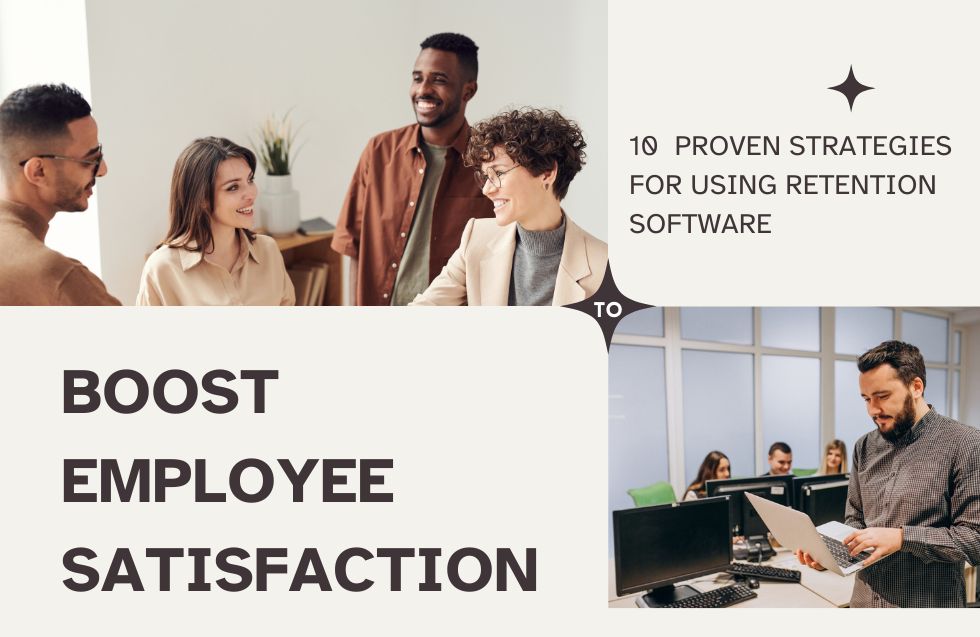In today’s fast-paced work environment, employee satisfaction is critical to maintaining a motivated and productive workforce. One powerful tool that can help companies improve employee satisfaction is retention software. These platforms provide data-driven insights that allow businesses to manage employee needs better, anticipate turnover risks, and foster a positive work culture. Below are ten proven strategies for using retention software to enhance employee satisfaction.
1. Leverage Data to Identify Employee Pain Points
Retention software allows employers to collect and analyze data on employee sentiment and behavior. Regularly reviewing this data can help identify common pain points—whether it’s workload, lack of career growth, or poor work-life balance—and provide an opportunity to address these issues proactively.
For example, data from Gallup shows that 53% of employees are not engaged in their work. By using software to identify specific pain points—whether related to workload, communication, or management—you can address issues before they escalate.
In a survey by Work Institute, 92% of employees stated they would stay if companies addressed their concerns early on. By identifying these concerns using retention software, you can act proactively to improve satisfaction.
2. Implement Personalized Employee Development Plans
Employees who feel they are growing professionally are more likely to stay with a company. Use retention software to track individual employee performance, identify skill gaps, and create personalized development plans. Employees who see a clear career path are more engaged and satisfied.
Data shows that 94% of employees would stay with a company longer if it invested in their learning and development (LinkedIn Workplace Learning Report). Retention software helps managers create individualized plans that map out professional growth, track milestones, and provide the resources needed for skill enhancement.
3. Monitor and Improve Employee Engagement
Engagement levels often correlate directly with employee satisfaction. Retention software can track engagement metrics, such as participation in meetings, responses to surveys, and overall workplace involvement. Use these insights to design activities or initiatives that boost engagement.
A Harvard Business Review study revealed that companies with highly engaged employees experience a 22% increase in profitability. Engagement tracking allows you to pinpoint disengaged teams and offer initiatives like team-building activities, training, or more frequent manager check-ins.
4. Predict and Mitigate Turnover Risks
One of the key features of retention software is its predictive analytics capability. By analyzing patterns such as absenteeism, declining performance, or disengagement, you can identify employees who may be at risk of leaving. Address these concerns early with interventions like check-ins or adjustments to workloads.
According to SHRM, employee turnover costs U.S. companies nearly $1 trillion per year, with the average cost to replace an employee being six to nine months’ salary. By using predictive tools to anticipate and mitigate turnover risks, you can implement retention strategies—such as one-on-one meetings, workload adjustments, or offering new challenges—that prevent costly exits.
5. Provide Real-Time Feedback and Recognition
Employees value timely feedback, whether it’s positive recognition or constructive suggestions for improvement. Retention software can integrate with performance management systems to provide real-time feedback. Recognizing employees’ achievements or providing actionable feedback when it matters can significantly improve satisfaction.
According to a study by TINYpulse, 21.5% of employees who don’t feel recognized will actively seek a new job. Regular feedback helps keep employees on track and engaged while also giving managers an opportunity to recognize and celebrate achievements.
6. Improve Work-Life Balance with Flexibility Options
Retention software can help you assess how employees are balancing their personal and professional lives. By analyzing hours worked, participation rates in flexible scheduling, or remote work options, employers can adopt policies to support better work-life balance. Offering flexibility is a proven way to increase employee happiness.
A survey by FlexJobs shows that 80% of employees would be more loyal if offered flexible work options. By using software to monitor work-life balance, employers can adjust schedules, reduce burnout, and improve satisfaction.
7. Create a Collaborative Culture
Retention software can track collaboration trends, helping you identify teams or individuals who may feel isolated or disconnected. You can use this data to encourage more cross-team collaboration or implement team-building exercises that foster a sense of community and improve employee satisfaction.
Forbes reports that companies promoting collaboration are five times more likely to be high-performing. Retention software can identify silos and disconnections among teams, allowing you to implement cross-functional projects or encourage better collaboration tools.
8. Enhance Workplace Transparency
Transparency is a key factor in employee trust and satisfaction. By regularly communicating company updates and decisions through the software, employees feel more connected to the organization. Use tools within retention software to send out surveys, updates, or conduct town hall meetings, keeping communication lines open.
A survey by TINYpulse found that employees who feel management is transparent are 30% more likely to remain at the company. Use retention software to enhance transparency by regularly sharing important updates, company performance data, and decisions affecting the workforce.
9. Personalize Employee Benefits
Employees have different needs and preferences when it comes to benefits. Retention software can provide insight into what benefits are most valued by your workforce, whether it’s healthcare, mental wellness programs, or tuition reimbursement. Tailor your benefits package based on this data to maximize employee satisfaction.
A report by SHRM shows that 72% of employees rank customizable benefits as a key factor in job satisfaction. Retention software allows you to analyze what specific benefits resonate most with your employees and adjust offerings to increase satisfaction and loyalty.
10. Streamline Onboarding Processes
An employee’s first impression during the onboarding process can greatly influence their satisfaction. Use retention software to streamline onboarding by automating tasks, monitoring the completion of training modules, and collecting feedback on the onboarding experience. A smooth and welcoming process can set the tone for long-term satisfaction.
Research from Glassdoor indicates that companies with a strong onboarding process improve new hire retention by 82% and productivity by over 70%. Retention software can automate and streamline onboarding tasks, ensuring new employees feel welcomed and fully integrated into their roles quickly.
Final Thoughts
Retention software is a powerful tool for boosting employee satisfaction when used strategically. By leveraging data-driven insights and implementing the above strategies, you can create a more engaged, productive, and satisfied workforce, leading to reduced turnover and improved business outcomes.
Boosting employee satisfaction doesn’t happen overnight, but with the help of retention software, you can build a work environment where employees feel valued and motivated to stay long-term.












